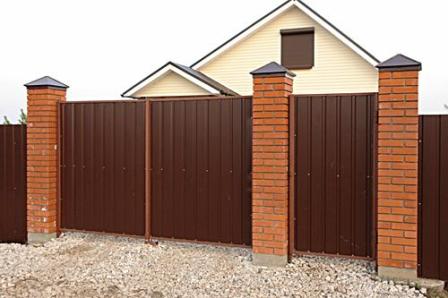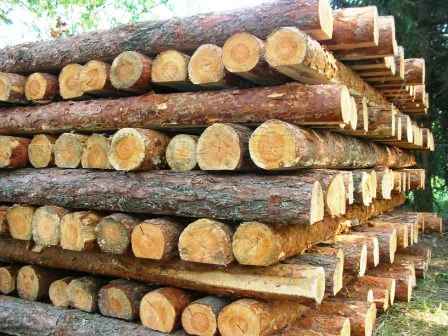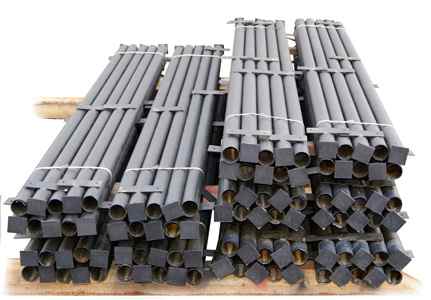Fencing gardening or any other territory requires competent approach to the choice of materials. You must take care not only about the aesthetics of the protective structure, but also its strength. For secure mounting, suitable for fence posts. About how they need to pick up on what to look for cover in this article.
Content
What are the pillars under the fence
- Wooden poles are not cheap, but reliability is not different. Wood and a half or two decades can fully come into disrepair. To increase the service life of the pillars made of wood material is treated with an antiseptic composition. In addition, an additional protection of the underground part with the help of coating bituminous composition. Applied firing: the stake or with a blowtorch timber is processed to the state of carbonization. Wooden poles mounted in specially prepared wells, and then fill the free space broken brick and fine gravel, which is tamped. Such support is used to picket and plank fences.
- Pillars made of asbetic pipes are relatively cheap, which is important for the construction of temporary fences. The disadvantage of this type of pillars is the presence of cavity: when the pipe moisture can also burst. Weak mechanical strength is also not in favor of this choice, but if the cavity is filled with reinforcement and concrete, you can get a solid design. Fasten lagows to such pipes with the help of clamps, which is not too convenient and reliable. But for the fence of not too important territories, it is best to use such pillars for fences: the price of them several times less than any other material.
- Metal poles for fences are most often used. Such a popularity is required by high strength, which allows them to attach almost any kind of fence. To protect the metal from corrosion, pillars (pipes, corners, channels, etc.) are treated with orthophosphoric acid, coated with protective paint and reversible mastic. Metal pillars can serve several times longer than from another material.
- Concrete pillars for fences are manufactured both in factory conditions and independently. At the same time, in both cases, it is important to comply with technology (the correct ratio of sand and cement, the presence of reinforcement and the use of the vibration-seeking) to achieve quality. The concrete pillars are distinguished by high strength, resistant to external influences under the condition of waterproofing of the underground part. They are fixed with fencing from concrete, made of metal, such pillars are well combined with bricks and with a tree.
- Brick pillars have high aesthetic qualities. But in order to achieve a good result, it is necessary to make a lot of effort: the construction of such columns is the process of time consuming, which requires compliance with the vertical and horizontal levels of masonry, the correct linking, bunch, etc. Early such pillars after special training pit, on the bottom of which sand is poured, which is compacted, then the layer of rubble and bitumen waterproofing. The underground part of the poles is constructed only from ceramic, normally burned bricks.
We select pillars according to the material of the fence
In order for the fence not only to look good, but also served as a reliable obstacle to unauthorized penetration into the fenced territory, the materials should be properly chosen to each other. Specialists are recommended to observe the following bundles:
- For a fence from a professional flooring, you can use any columns. The small weight of metal sheets with a thickness of 1.5-2 mm does not create a load. But from a practical point of view, the best columns will be brick and metallic.
- The fence from the chain grid must be attached to the columns capable of withstanding its weight and tension. For this, beabiled metal columns and heavy concrete are well suited for this.
- Brick fences are combined only with brick or concrete columns with lower ligation. Poles from other material are not suitable: they will not stand the load.
- The fence from concrete slabs can be installed with concrete pillars or thick-walled metal pipes.

Given these recommendations, you can choose correctly, make or buy pillars for fences. At the same time, the architecture of the cottage should be taken into account: a brick or concrete fence is combined with a brick structure, a stakenier or a boardy fence, and the house, covered with siding, is protected by profiled sheets fixed on metal columns.
Installing posts for fence
To determine the method of fencing should be subject to not only the nature of the structure, but also the type of soil. After the choice in favor of this or that material of the fence is finally done and the necessary materials are purchased, you can begin work. Phased this process can be described as follows.
- A general fence plan is drawn up, marking on the ground and cleaning the territory.
- On the perimeter of the fence is prepared in the ground: the distance between them depends on the size of the sections. To stretch the chain mesh, the distance between the columns should not exceed 3 m. The same distance is selected for a stake or a fever. A smaller distance makes the design more durable, but its value increases significantly.
- When the columns are swapped, you need to choose the right depth: the higher the massive post, the greater should be the underground part.
- The height of the columns should be the same in areas with smooth soil. This is checked by a water level.
- Metal pillars should be concreted: the hole after installing the pipes or chapellers filled with concrete. At the same time, the pillar should be temporarily fixed in a vertical position using backups and stretch marks to harvesting concrete.
- The brick pillars should be strengthened with metal: inside them there must be rods, their clutch of the round or square section. To create a rigid design, the upper and lower jumpers are welded between them, which will then serve as lags. Another way to strengthen is the placement of a frame of a frame of a frame of a frame from the reinforcement, which is subsequently poured with concrete.
- The vertical of the pillars is constantly verified using a construction level and a plumb.
- After installing the columns, you can start fastening the lag and the fence shields.
At the end of the article - video about installing a fence from a professional flooring.























